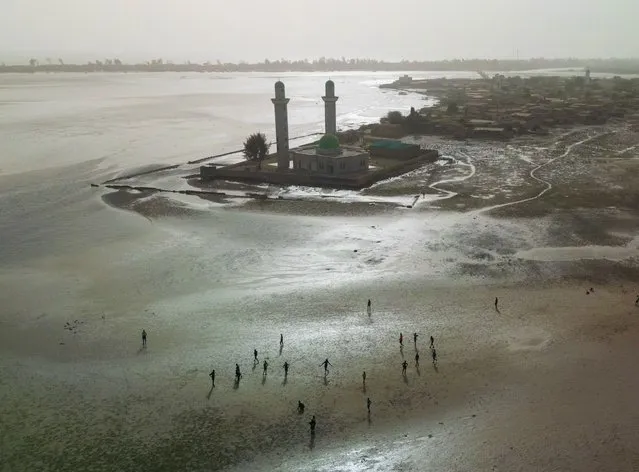
An aerial view of the Fadiouth Island, also known as shell island (Ile aux coquillages) about 150 kilometers from the capital Dakar, in the Thies Region at the end of the Petite Cote of Senegal, on April 11, 2024. Linked to the mainland by a narrow wooden bridge, Fadiouth lies on an island of clam shells, was formed in the 11th century as a result of human habits, according to the belief. (Photo by Cem Ozdel/Anadolu via Getty Images)
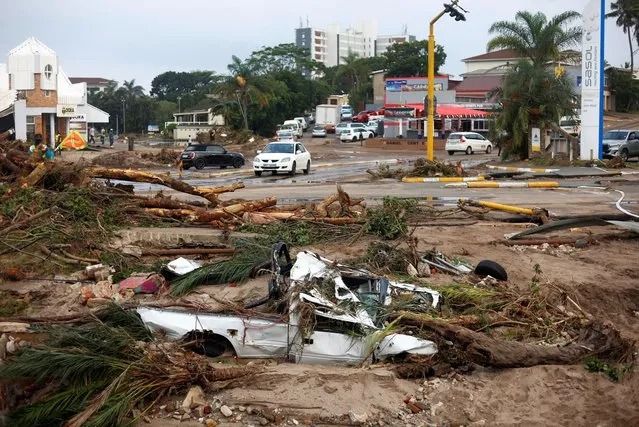
A car is buried in the sand after flooding caused extensive damage in Margate, South Africa on April 15, 2024. (Photo by Rogan Ward/Reuters)
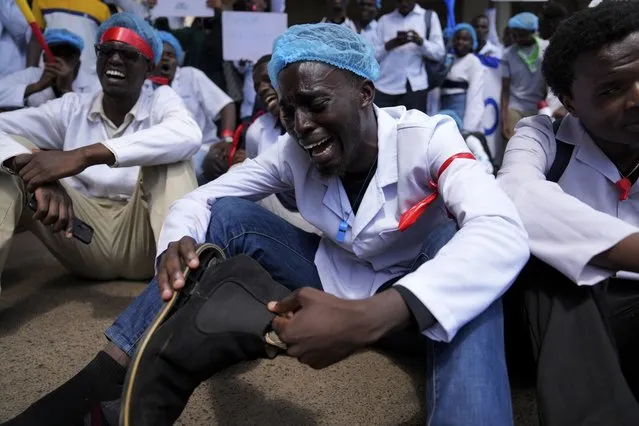
Doctors and other medical staff take part in a protest, in downtown Nairobi, Kenya, Tuesday, April 16, 2024. Hundreds of Kenyan doctors have protested in the streets demanding better pay and working conditions in an ongoing nationwide strike for about a month. The doctors carried placards and chanted against the Kenyan government on Tuesday, saying it had failed to implement a raft of promises, including a collective bargaining agreement signed in 2017 after a 100-day strike during which people died from lack of care. (Photo by Brian Inganga/AP Photo)
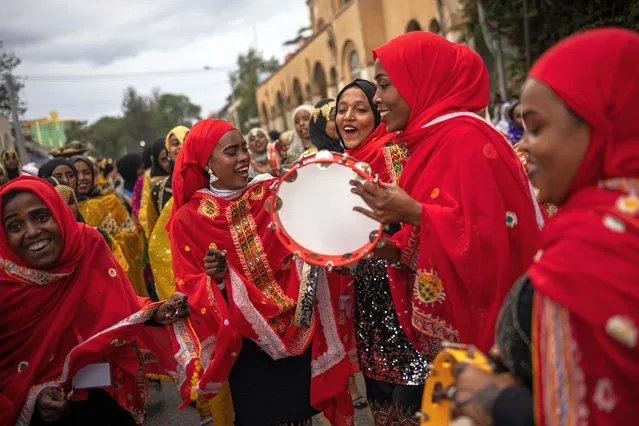
Young women dressed in traditional attires chant and dance during the celebration for the Shuwalid festival in Harar on April 16, 2024. Shuwalid is an annual festival celebrated by the Harari people of Ethiopia and marks the end of six days of fasting to compensate omissions during Ramadan. Founded in the 10th century, Harar – also called Jugol – is reputed to be one of the oldest cities in east Africa and the fourth holiest city in the Islamic world – after Mecca, Medina and Jerusalem – with locals boasting it has the highest concentration of mosques and shrines in the world. The old town has been enclosed by a four-metre high wall since 1551 and mostly forbidden to non-Muslims until 1887 when it was conquered by Ethiopia's Emperor Menelik II. Long years of enclosure allowed Harari culture to flourish and its dwellers became famous for a modern trade system, hand-bound books, Islamic teaching, poetry and lively religious festivals, which make up Harar's unique identity. (Photo by Michele Spatari/AFP Photo)
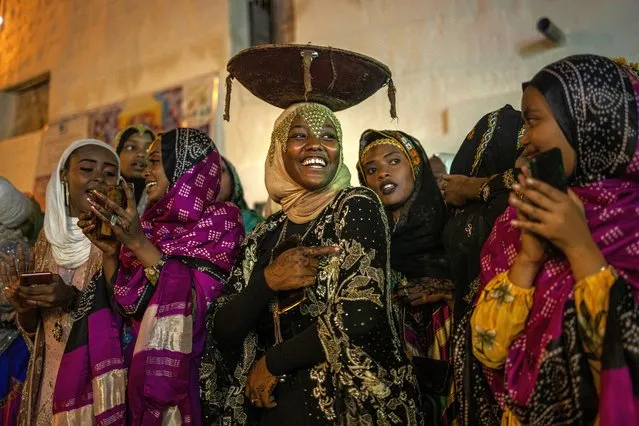
Young women dressed in traditional attires sing and dance during the celebration for the Shuwalid festival in Harar, Ethiopia on April 16, 2024. (Photo by Michele Spatari/AFP Photo)
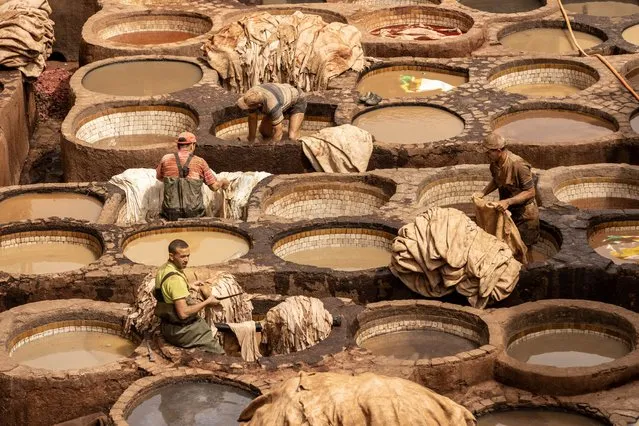
Circular shaped large stone wells are seen on a large area where the coloring process of the leathers take place at the Shuvwara Tannery in Fez, Morocco on April 17, 2024. Shuvwara Tannery is considered to be the oldest tannery on the Arab geography and has been operating since the 11th century. The colored leathers are produced with natural methods for hundreds of years and still continue to be a source of livelihood for thousands of Moroccan citizens. (Photo by Nurettin Boydak/Anadolu via Getty Images)
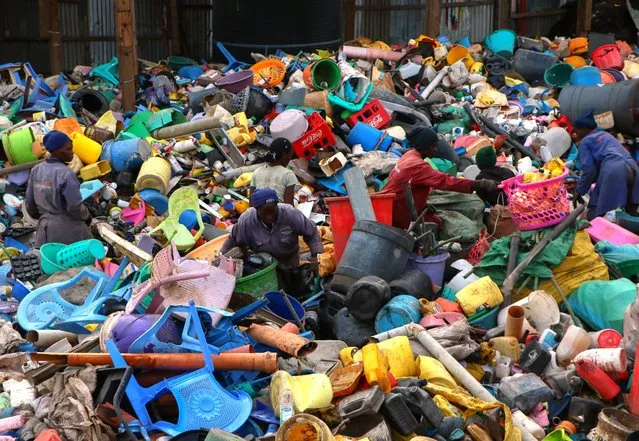
Kenyan workers collect plastic waste for recycling in Nakuru, Kenya on April 17, 2024. Workers grind the thousands of tons of waste they collect into small pieces at an enterprise in the city. The shredded plastics are then placed in sacks and sold to companies for recycling. (Photo by James Kamau/Anadolu via Getty Images)
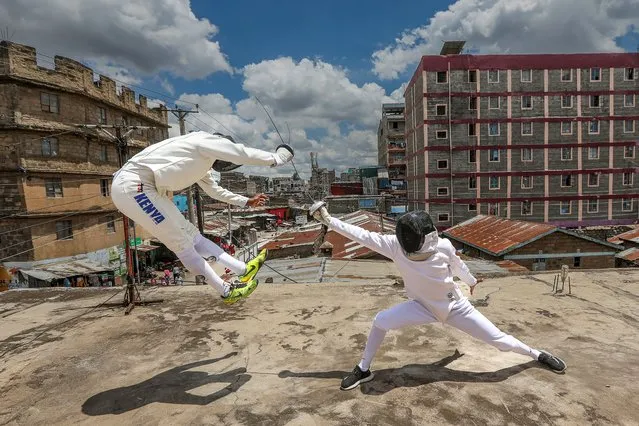
Kenyan professional fencer Isaac Mburu Wanyoike (L) trains with teenage members of the Tsavora Fencing Mtaani club on a rooftop of the Huruma slum in Mathare, Nairobi, Kenya, 17 April 2024. The Tsavora Fencing Mtaani club was founded by Isaac Mburu Wanyoike, a gang member turned pro-fencer, the first Kenyan to represent the country in international fencing competitions, and the current coach for Kenya’s Fencing team. “I wanted to change to be an example in the community, a positive figure”, Mburu said. Mburu is bringing a new hope to Kenyan youths in the Huruma slum by engaging them in fencing, using the streets as their arena as they parry and riposte in front of curious onlookers. They also go to Nairobi’s central business district to show-fence to members of the public as a way to raise funds that support them in acquiring training kits and building a dedicated facility. Tsavora depends in part on the will of the people, although much of its budget comes from fee-paying international school programs and private classes. More than a hobby for the young athletes, fencing has helped them carve a path away from crime, drug abuse, teenage pregnancies and other social pressures. Today the club has 45 students and has become a reference for the suburb of Mathare, the second largest suburb of Nairobi. Mburu will travel to Algeria to take part in the Zonal Qualifying Tournament for the 2024 Paris Olympics qualifiers. (Photo by Daniel Irungu/EPA/EFE)

A member of the Fientan group, a contemporary dance company of young deaf and mute people from Burkina Faso, performs during the Market for Performing Arts in Abidjan (MASA), at the Culture Palace in Abidjan, Ivory Coast on April 17, 2024. (Photo by Luc Gnago/Reuters)

Surfers stand on Muizenberg beach in the early morning as seasonal mist shrouds the sun in Cape Town, South Africa, on April 18, 224. (Photo by Esa Alexander/Reuters)
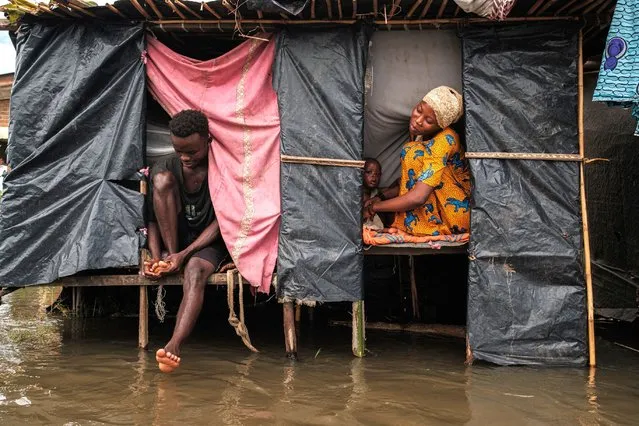
Uwurukundo Zilfa (R) sits next to her husband and kid inside their temporary shelter after being displaced following flash floods in the Gatumba district of Bujumbura, on April 19, 2024. The government of Burundi and the United Nations have launched an appeal for financial aid to cope with the “devastating effects” of months of relentless rainfall that has displaced nearly 100,000 people. East Africa has been experiencing torrential rains in recent weeks that have cost the lives of at least 58 people in Tanzania in the first half of April, and 13 people in Kenya. (Photo by Tchandrou Nitanga/AFP Photo)
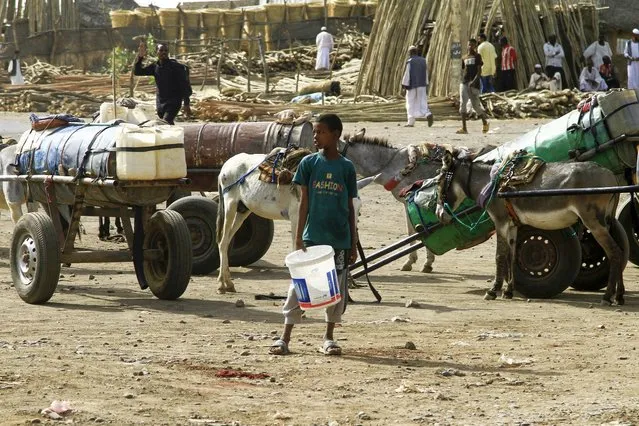
People use barrels mounted on donkey-pulled carts to transport water in the southern Sudanese city of Gadaref on April 21, 2024. (Photo by Ebrahim Hamid/AFP Photo)
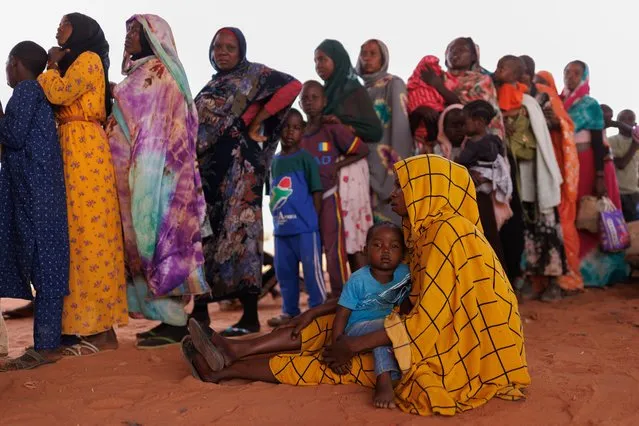
Newly arrived refugees fleeing fighting in Darfur queue to have their documents processed in the shade of a partially finished bridge at the border of Sudan and Chad on April 22, 2024 in Adre, Chad. Since the beginning of the recent conflict between the paramilitary Rapid Support Forces (RSF) and the the Sudanese Armed Forces, (SAF), which began in March 2023, over 600,000 new refugees have crossed the border from Darfur in Sudan, into Chad. The total number of refugees, including those from previous conflicts, now stands at 1.2 million. Aid agencies, including The World Food Programme, (WFP), Médecins Sans Frontières (MSF) and the United Nations High Commissioner for Refugees, (UNHCR), already struggling with accute supply shortages, have warned that the life-saving programmes in Chad, will “grind to a halt in a matter of weeks without urgent funding”. Chad is now home to one of the largest and fastest-growing refugee populations in Africa. (Photo by Dan Kitwood/Getty Images)
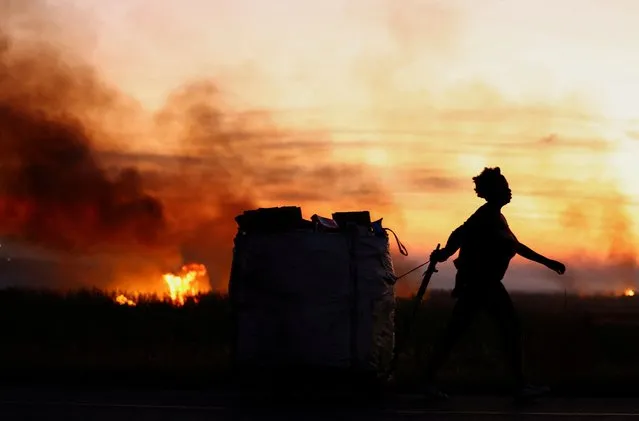
A woman pulls a trolley with recyclable material past veld fires occurring as winter approaches, in Lenasia in the south of Johannesburg, South Africa on April 22, 2024. (Photo by Siphiwe Sibeko/Reuters)
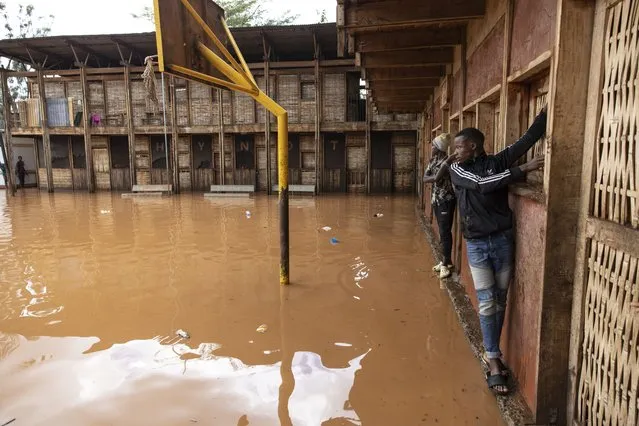
Residents of Mathare slum use the wall to cross a flooded school field, following heavy down pour in the capital, Nairobi on April 24, 2024. Storms and flash floods wreaked devastation across the Kenyan capital Nairobi on April 24, 2024, claiming at least four lives. (Photo by Simon Maina/AFP Photo)
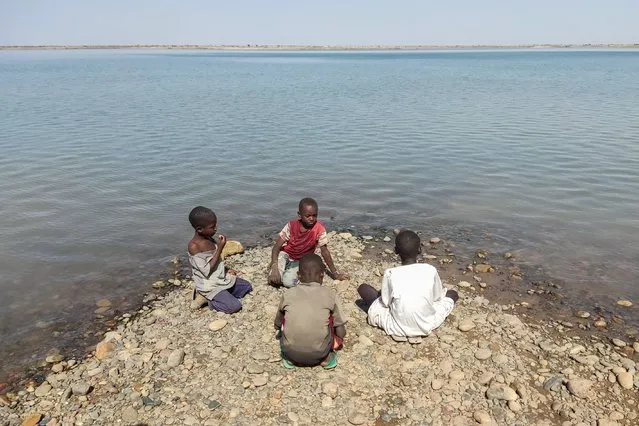
Children sit on the bank of the river Seteit in Gadaref state in eastern Sudan on April 24, 2024. The war in Sudan – which experts have warned could last for years – has pushed 18 million Sudanese into acute food insecurity, five million of whom are on the brink of famine. The international community pledged earlier this week more than two billion euros in aid to Sudan, only half of what the UN demanded, during a meeting in Paris. (Photo by AFP Photo/Stringer)
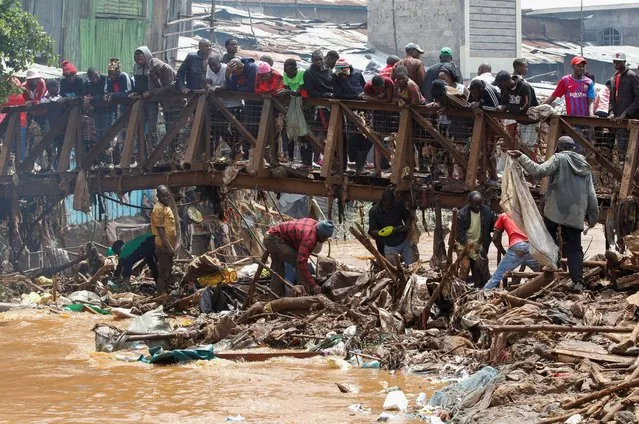
Residents sift through the rubble as they recover their belongings after the Nairobi river burst its banks and destroyed their homes within the Mathare Valley settlement in Nairobi, Kenya on April 25, 2024. (Photo by Monicah Mwangi/Reuters)
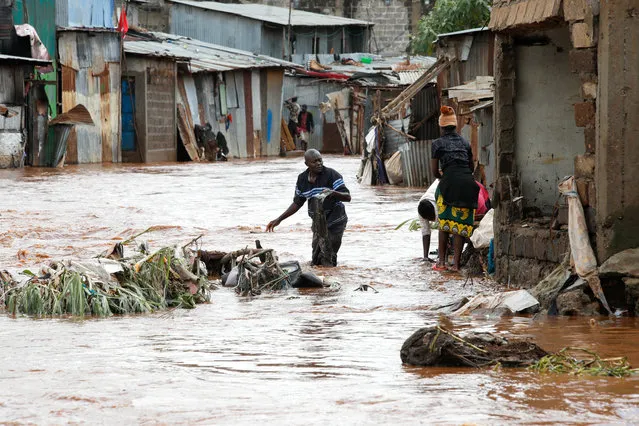
Residents wade through flood waters as they recover their belongings after the Nairobi river burst its banks within the Mathare valley settlement in Nairobi, Kenya on April 24, 2024. (Photo by Monicah Mwangi/Reuters)
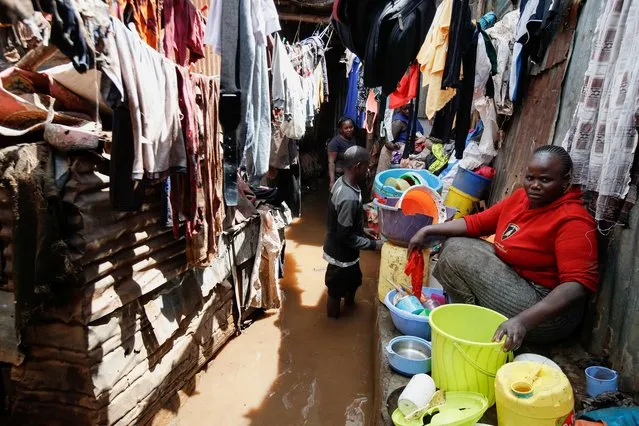
Juliet Akoth sits next to her belongings recovered from her flooded house after the Nairobi river burst its banks within the Mathare valley settlement in Nairobi, Kenya on April 24, 2024. (Photo by Monicah Mwangi/Reuters)
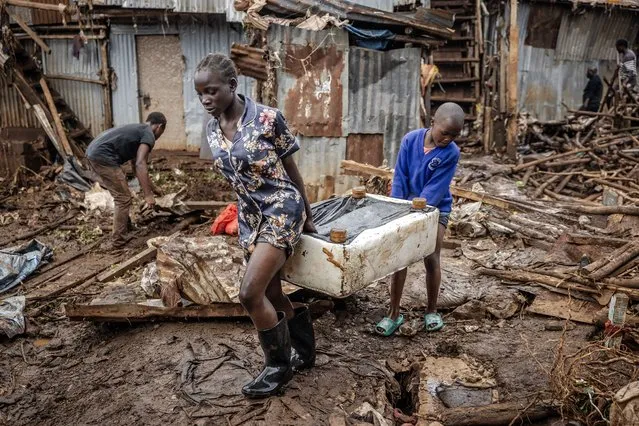
A girl and a boy carry a piece of furniture after visiting their house that was destroyed by floods following torrential rains at the Mathare informal settlement in Nairobi, on April 25, 2024. Torrential rains triggered floods and caused chaos across Kenya, blocking roads and bridges and engulfing homes in slum districts. The death toll from flash floods in Kenya's capital Nairobi has risen to 13 on April 25, 2024, police said. Kenyans have been warned to stay on alert, with the forecast for more heavy rains across the country in the coming days. (Photo by Luis Tato/AFP Photo)
27 Apr 2024 05:34:00,
post received
0 comments
